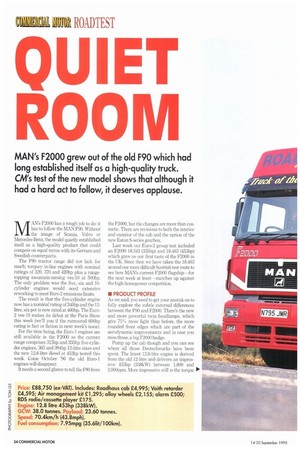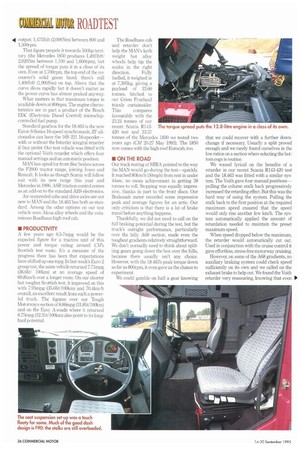LIET ROOM
Page 36

Page 38

Page 40

Page 41

If you've noticed an error in this article please click here to report it so we can fix it.
MAN's F2000 grew out of the old F90 which had long established itself as a high-quality truck. CM's test of the new model shows that although it had a hard act to follow, it deserves applause.
MAN's F2000 has a tough job to do: it has to follow the MAN F90. Without the image of Scania, Volvo or Mercedes-Benz, the model quietly established itself as a high-quality product that could compete on equal terms with its German and Swedish counterparts.
The F90 tractor range did not lack for much; torquey in-line engines with nominal ratings of 320, 370 and 420hp plus a rangetopping mountain-taming vee-10 at 500hp. The only problem was the five, six and 10cylinder engines would need extensive reworking to meet Euro-2 emissions limits.
The result is that the five-cylinder engine now has a nominal rating of 340hp and the 12litre, six-pot is now rated at 400hp. The Euro2 vee-10 makes its debut at the Paris Show this week (we'll you if the rumoured 600hp rating is fact or fiction in next week's issue), For the time being, the Euro-1 engines are still available in the F2000 so the current range comprises 315hp and 335hp five-cylinder engines, 365 and 394hp 12-litre sixes and the new 12.8-litre diesel at 453hp tested this week. Come October '96 the old Euro-1 engines will disappear.
It needs a second glance to tell the F90 from the F2000, but the changes are more than cosmetic. There are revisions to both the interior and exterior of the cab and the option of the new Eaton S-series gearbox.
Last week our Euro-2 group test included an F2000 18.343 (335hp) and 18.463 (453hp) which gave us our first taste of the F2000 in the UK. Since then we have taken the 18.463 around our more difficult Scottish test route to see how MAN's current F2000 flagship—for the next week at least—matches up against the high-horsepower competition.
• PRODUCT PROFILE
As we said, you need to get your anorak on to fully explore the subtle external differences between the F90 and F2000. There's the new and more powerful twin headlamps, which give 75% more light than before, the more rounded front edges which are part of the aerodynamic improvements and in case you miss those, a big F2000 badge.
Pump up the cab though and you can see where all those Deutschmarks have been spent. The latest 12.8-litre engine is derived from the old 12-litre and delivers an impressive 453hp (338kW) between 1,800 and 2,000rpm. More impressive still is the torque output; 1,475Ibft (2,000Nm) between 800 and 1,50Orpm.
That figure propels it towards 500hp territory (the Mercedes 1850 produces 1,4911bfti 2,020Nm between 1,100 and 1,600rpm), but the spread of torque puts it in a class of its own. Even at 1,700rpm, the top end of the rev counter's solid green band, there's still 1,400Ibft (1,9()0Nm) on tap. Above that the curve dives rapidly but it doesn't matter as the power curve has almost peaked anyway.
What matters is that maximum torque is available down at 800rpm. The engine characteristics are in part a product of the Bosch EDC (Electronic Diesel Control) microchipcontrolled fuel pump.
Standard gearbox for the 18.463 is the new Eaton S-Series 16-speed synchromesh. ZF aficionados can have the 165 221 16-speederwith or without the Intarder integral retarder if they prefer. Our test vehicle was fitted with the optional Voith retarder which offers four manual settings and an automatic position.
MAN has opted for front disc brakes across the F2000 tractor range, joining Iveco and Renault. It looks as though Scania will follow suit with its new range this year and Mercedes in 1996. ASR traction control comes as an add-on to the standard ABS electronics.
Air-suspended cabs and drive axles are not new to MAN and the 18.463 has both as standard. Among the other options on our test vehicle were Alcoa alloy wheels and the voluminous Roadhaus high-roof cab.
• PRODUCTIVITY
A few years ago 6.5-7mpg would be the expected figure for a tractive unit of this power and torque rating around C114's Scottish test route. It's a measure of the progress there has been that expectations have shifted up one mpg In last week's Euro-2 group test, the same vehicle returned 7.71mpg (36.6141 100km) at an average speed of 69.8km/h over a longer route. On our shorter but tougher Scottish test, it improved on this with 7.95mpg (35.61it/100km) and 70.4km/h overall, an excellent result from such a powerful truck. The figures over our Tough Motorways section of 8.86mpg (31.81ft/100km) and on the Easy A-roads where it returned 8.75mpg (32.31it/100km) also point to its longhaul potential. The Roadhaus cab and retarder don't help the MAN's kerb weight but alloy wheels help tip the scales in the right direction. Fully fuelled, it weighed in at 7,395kg, giving a payload of 23.60 tonnes, hitched to our Crane Fruehauf triaxle curtainsider.
This compares favourably with the 23.24 tonnes of our recent Scania P14342() test and 23.37 tonnes of the Mercedes 1850 we tested two years ago (CM 20-27 May 1993). The 1850 now comes with the high-roof Eurocab, too.
• ON THE ROAD
Our track testing at MIRA pointed to the way the MAN would go during the test—quickly. It reached 80km/h (50mph) from rest in under 44,sec, no mean achievement in getting 38 tonnes to roll. Stopping was equally impressive, thanks in part to the front discs. Our Brake.safe meter recorded some impressive peak and average figures for an attic. Our only criticism is that there is a lot of brake travel before anything happens.
Thankfully, we did not need to call on the full braking potential during the test, but the truck's outright performance, particularly over the hilly A68 section, made even the toughest gradients relatively straightforward. We don't normally need to think about splitting gears going down the box over the hills, because there usually isn't any choice. However, with the 18.463's peak torque down as far as 800rpm, it even gave us the chance to experiment.
We could gamble on half a gear knowing that we could recover with a further downchange if necessary. Usually a split proved enough and we rarely found ourselves in the low ratios on a section where selecting the bottom cogs is routine.
We waxed lyrical on the benefits of a retarder in our recent Scania R143-420 test and the 18.463 was fitted with a similar system. The Voith gave four manual positions— pulling the column stalk back progressively increased the retarding effect. But this was the hard way of using the system. Pulling the stalk back to the first position at the required maximum speed ensured that the speed would only rise another few km/h. The system automatically applied the amount of retardation needed to maintain the preset maximum speed.
When speed dropped below the maximum, the retarder would automatically cut out. Used in conjunction with the cruise control it gave effortless, stress-free motorway cruising.
However, on some of the A68 gradients, no auxiliary braking system could check speed sufficiently on its own and we called on the exhaust brake to help out. We found the Voith retarder very reassuring, knowing that even III
.4 under long brake applications there was another system hauling us back. The benefits the system are increased brake life and reduced driver stress. It must be worth the cost and small weight penalty a retarder carries.
• CAB COMFORT MAN has opted for comfort overkill with the suspension set up on the 18.463. On top of the ECAS air-suspended drive axle, there is fourpoint cab air suspension and an air-suspended driver's seat. This in turn has three different adjustable pneumatic lumbar supports and an electric bum warmer with dashmounted thermostat for those cold starts.
Left to its own devices, we found the system delivered too much float except over smooth motorway surfaces. We preferred to lock up the air suspended seat over the poorer quality roads.
The driver's seat also has an air dump to ease access and departure by dropping the seat clear of the steering wheel. From there it's three broad illuminated steps down to the tarmac.With such a tall cab and the suspension setup, a degree of cab roll was expected. We didn't find it to be excessive, though.
Instrumentation is carried over from the F90—no bad thing. The tacho and revcounter are large and clearly marked. Most of the switch gear is also repeated. That means the overworked column stalk controls indicators, wipers. washer, horn, headlamp flash and heaven knows what else. At least it frees up the right-hand side of the column for the cruise and retarder controls.
A re-sited radio is also welcome. It's now mounted at the bottom of the dash within reach and sight of the driver.
Drivers without a degree in astrophysics will be pleased to know that MAN sent in a human being to redesign the heater controls, Gone is the bank of vertical sliders with the incomprehensible markings. It's down to horizontal slides for temperature, screen, side demisters, floor and recirculation. Not only are they easy to use, but the system is very effective.
Throughput can be improved by opening the electrically controlled tilt/slide sunroof. What's more, this is not fitted under the air deflector kit feeding excessive noise into the cab. The result is good ventilation without excessive noise. There are also roof switches located over each bunk so drivers can breathe at night too.
Before the Volvo FH, MAN had the quietest cab available, even with the Roadhaus top. As our noise meter shows, the FH, at least with standard roof, has it beaten, but only just. This is probably due to the increased combustion noise from Euro-2 engines. Even so, the F2000 Roadhaus is still one of the quietest cabs in its class.
It is also one of the most voluminous. You need to be way over six foot to stoop when standing on the engine cover. There's stacks of stowage in the large lockers overhead at the front of the cab, ideal for weeks away on intercontinental work.
We'd have little hesitation in nominating the Roadhaus as probably the best cab avail able. It's Magnum without the mountaineering. The drawbacks? Those long door mirror combinations, including a long-distance mirror each side give excellent rearward visibility. Unfortunately, they all but destroy the front three-quarter view, making approaches to roundabouts unnecessarily tricky.
• SUMMARY This is an excellent all-round truck. The latest MAN six-cylinder engine combines low fuel consumption with superb performance and flexibility. Given the size of the cab, the ride and handling are pretty good too.
It's not only operators who should be smiling, this is probably the best cab available for drivers at present, although the competition hots up this week as Volvo unveils the Globetrotter XL at the Paris Show, and Scania unveils the Series 4 next month.
At £80,030 (ex-VAT) with the Roadhaus cab, the big MAN isn't cheap. The Scania R143 450 looks better value at £72,875 but there's no true high-roof option. Volvo's FH12 420 Globetrotter comes out at £71,750, but we don't know yet what the bigger XL cab will add to the price.
Among the big cabs, the MAN looks a better bet. Renault's Magnum 420 starts at £83,010, Leyland Dal's 95 Super Space Cab with 500hp costs £90,340 and Iveco Ford's EuroStar 420 from £77,810.
We like the 18.463 and we reckon owneroperators will too. We suggest they start queueing at their nearest MAN dealer now. 17 by John Kendall
















































































































